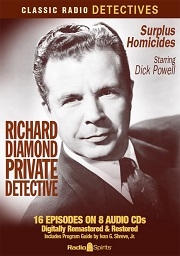
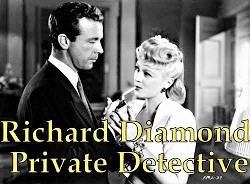 Richard Diamond, Private Detective (1949-52) aired “The House of Mystery Caper” on December 10, 1949 as its 33rd episode of some 141 original episodes. This is only the fifth Richard Diamond episode we’ve presented, the first being from early November of 2019, the second and third from June and July of 2020, and the last just over a year ago in May of 2021. Due to the popularity of the earlier shows I thought it might be a good idea to treat Diamond fans with another, especially since it’s been over a year since the last one. Therefore–-for newcomers to the show and those wishing to refresh their memories–-I reprise in slightly abbreviated form our earlier historical sketch of the program and its recurring characters.
Richard Diamond, Private Detective (1949-52) aired “The House of Mystery Caper” on December 10, 1949 as its 33rd episode of some 141 original episodes. This is only the fifth Richard Diamond episode we’ve presented, the first being from early November of 2019, the second and third from June and July of 2020, and the last just over a year ago in May of 2021. Due to the popularity of the earlier shows I thought it might be a good idea to treat Diamond fans with another, especially since it’s been over a year since the last one. Therefore–-for newcomers to the show and those wishing to refresh their memories–-I reprise in slightly abbreviated form our earlier historical sketch of the program and its recurring characters.
The show originally aired over NBC stations, then ABC, and then finally in 1953 by CBS, but all of the CBS shows were repeats from the 1950-51 season, thus some old time radio sites list the show’s run as going into 1953. Richard Diamond (starring film icon Dick Powell, 1904-1963, photo above right) was an ex-cop turned private detective who maintained good relations with his ex-boss and police lieutenant Walter Levinson (played by  Ed Begley [1901-1970, photo at left], probably most recognizable as juror #10 in the classic 1957 film Twelve Angry Men, and father to actor Ed Begley, Jr.). Diamond’s girlfriend, Helen Asher, was played by Virginia Gregg (1916-1986, photo below with Powell), who went on to have many film and television roles (including the Twilight Zone episode “The Masks” which aired March 20, 1964). The character of Richard Diamond–-and the radio program itself–-was the brainchild of Blake Edwards (1922-2010), perhaps best known for writing and directing the Pink Panther movies, as well as directing other fine films such as Operation Petticoat (1959), Breakfast at Tiffany’s (1961), and Days of Wine and Roses (1962). Blake’s private detective Richard Diamond didn’t exactly fit the standard mold people were used to, as typified in the novels of Dashiell Hammett and Raymond Chandler. While he could wisecrack with the best of them, he was also suave and sophisticated and tough as nails, living the high life in New York City when not found visiting the swank penthouse apartment of his girlfriend, Helen Asher. Being a well-seasoned song and dance man due to his many early movies where he inevitably ended up singing, Dick Powell was the perfect choice to play Richard Diamond, especially after his smashing success in 1944’s Murder, My Sweet. Audiences loved Powell as Diamond, so much so that the show’s popularity warranted its own television counterpart. It starred David Janssen (1931-1980) and ran from 1957-1960. Janssen, of course, is best remembered for his iconic role as Dr. Richard Kimble in the classic TV series The Fugitive (1963-67).
Ed Begley [1901-1970, photo at left], probably most recognizable as juror #10 in the classic 1957 film Twelve Angry Men, and father to actor Ed Begley, Jr.). Diamond’s girlfriend, Helen Asher, was played by Virginia Gregg (1916-1986, photo below with Powell), who went on to have many film and television roles (including the Twilight Zone episode “The Masks” which aired March 20, 1964). The character of Richard Diamond–-and the radio program itself–-was the brainchild of Blake Edwards (1922-2010), perhaps best known for writing and directing the Pink Panther movies, as well as directing other fine films such as Operation Petticoat (1959), Breakfast at Tiffany’s (1961), and Days of Wine and Roses (1962). Blake’s private detective Richard Diamond didn’t exactly fit the standard mold people were used to, as typified in the novels of Dashiell Hammett and Raymond Chandler. While he could wisecrack with the best of them, he was also suave and sophisticated and tough as nails, living the high life in New York City when not found visiting the swank penthouse apartment of his girlfriend, Helen Asher. Being a well-seasoned song and dance man due to his many early movies where he inevitably ended up singing, Dick Powell was the perfect choice to play Richard Diamond, especially after his smashing success in 1944’s Murder, My Sweet. Audiences loved Powell as Diamond, so much so that the show’s popularity warranted its own television counterpart. It starred David Janssen (1931-1980) and ran from 1957-1960. Janssen, of course, is best remembered for his iconic role as Dr. Richard Kimble in the classic TV series The Fugitive (1963-67).
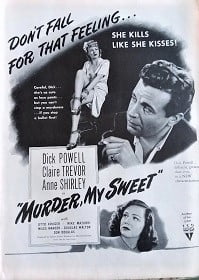 Dick Powell’s breakout film (briefly mentioned above) was 1944’s noir classic Murder, My Sweet. Based on Raymond Chandler’s detective character Philip Marlowe from his 1940 novel Farewell, My Lovely, the film was released with the book’s title but audience reaction was tepid at best, the feeling being that the title wasn’t dark enough and audiences assumed it was just another of Powell’s many light romances he had been making since the 1930s (30+ such roles from 1932-1939), in which he played handsome young men who wooed women with his boyish good looks, musical ability, and crooning voice. Getting older, and desirous of more mature roles that fit his middle aged demeanor, he convinced the powers that be to give him the role of Marlowe from Chandler’s novel. It was quite a gamble but Powell pulled it off admirably and the film is now recognized as a noir classic. When the film was released in late December of 1944 with the novel’s title and proved unsuccessful at the box office, it was quickly retitled Murder, My Sweet and re-released in February of 1945 in St. Louis with much better results. The box office and critical acclaim following the film led to several other noir films of note with Powell in the lead: Johnny O’Clock (1947, in which he played a detective), To the Ends of the Earth (1948, crime noir), and Pitfall (also 1948, film noir where he starred as a bored insurance agent who falls in love with the wrong woman).
Dick Powell’s breakout film (briefly mentioned above) was 1944’s noir classic Murder, My Sweet. Based on Raymond Chandler’s detective character Philip Marlowe from his 1940 novel Farewell, My Lovely, the film was released with the book’s title but audience reaction was tepid at best, the feeling being that the title wasn’t dark enough and audiences assumed it was just another of Powell’s many light romances he had been making since the 1930s (30+ such roles from 1932-1939), in which he played handsome young men who wooed women with his boyish good looks, musical ability, and crooning voice. Getting older, and desirous of more mature roles that fit his middle aged demeanor, he convinced the powers that be to give him the role of Marlowe from Chandler’s novel. It was quite a gamble but Powell pulled it off admirably and the film is now recognized as a noir classic. When the film was released in late December of 1944 with the novel’s title and proved unsuccessful at the box office, it was quickly retitled Murder, My Sweet and re-released in February of 1945 in St. Louis with much better results. The box office and critical acclaim following the film led to several other noir films of note with Powell in the lead: Johnny O’Clock (1947, in which he played a detective), To the Ends of the Earth (1948, crime noir), and Pitfall (also 1948, film noir where he starred as a bored insurance agent who falls in love with the wrong woman).
Powell was also active in television as actor, director, and producer. Arguably his best known TV endeavor was Dick Powell’s Zane Grey Theater or as it came to be known, simply Zane Grey Theatre (1956-1961). It was a western anthology series based on the works of Zane Grey, but as time went on new material was added to keep the stories fresh. It guest-starred many of the most well known or beloved and/or major TV/movie stars of the day, including but not limited to: Anne Bancroft, Robert Blake, Ernest Borgnine, Lloyd Bridges, Claudette Colbert, Hedy Lamarr, Julie London, Ginger Rogers, James Garner, Dennis Hopper, Burl Ives, Michael Landon, Edward G. Robinson, Jack Lemmon, David Niven, John Dehner, Burt Reynolds, Lon Chaney, Jr., Barbara Stanwyck, and many more. Much beloved in Hollywood and throughout the country by his legion of fans, Dick Powell died on February 3, 1963. His widow, well known actress June Allyson, gave his cause of death as lung cancer due to his chain smoking. Powell has a star on the Hollywood Walk of Fame.
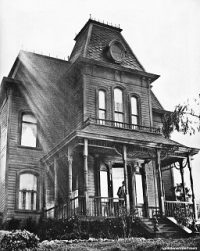 Last week’s Suspense episode dealt with one of the complications of what I term the “inherit the will” premise. This week we have another and it clearly illustrates how imaginative writers can be in treating the same theme in a wildly different manner. A man and wife own a large old house with many dark and twisting passageways. One notices that its many windows are shuttered to the outside world. It is highly reminiscent of the spooky Bates Motel of horror fame. Indeed, the last name of the husband and wife is Bates. I find it curious to note that Robert Bloch’s famed novel Psycho—written in 1959 and filmed by Alfred Hitchcock in 1960—featured the now iconic Bates Motel, another rickety-looking old multi-storied house, whose sole owner is one Norman Bates. The similarities between the two houses and their owners’ identical surnames are unmistakable, and reminds one of the the old adage: “Originality is the art of concealing your source.” Did Bloch get his inspiration for his Bates Motel from this episode of Richard Diamond, Private Detective, nearly 10 years before he wrote Psycho? In any case, the husband in this story is a true believer in the supernatural and all things related to the spirit world. When he dies, he is buried in a casket in the cellar of his large old house with instructions that to inherit whatever wealth he has accumulated his wife must remain in the house for a full three months, at which time he will return and escort his wife into the spirit world, where they will live happily ever after. If she breaks the will all monies will go to a charity. It is the night before Mrs. Bates’ husband is to return from the dead and she is terrified. If she happens to get herself murdered her death breaks the condition of the will. She pays Diamond to stay with her in case something should happen, and he reluctantly agrees (for $100). All sorts of shenanigans and strange occurrences happen the night before Mr. Bates has prophesied his return from the dead, and Diamond is half-convinced of their reality. The growing sense of dread and suspense is broken only by the butler, Cain, who plays his role half the time with tongue buried deeply in his cheek and half in total seriousness, his lines delivered so as to guarantee a smile or chuckle from the listener. Since the rest of the front story is played dead serious, this purposeful levity by the butler makes for a perfectly balanced spook story. The butler is a hoot and is worth the price of admission all by himself as the unintended show stealer in “The House of Mystery.” But wait, you ask breathlessly. Does the husband indeed return from the dead, and when all is said and done and the dust clears—who ends up with the inheritance? Will it be someone you may have guessed or someone you may have overlooked, given the deftly placed clues sprinkled throughout the story. For the answers to these questions you’ll have to set aside a mere half hour of quiet time and listen to this lively episode of Richard Diamond, Private Detective!
Last week’s Suspense episode dealt with one of the complications of what I term the “inherit the will” premise. This week we have another and it clearly illustrates how imaginative writers can be in treating the same theme in a wildly different manner. A man and wife own a large old house with many dark and twisting passageways. One notices that its many windows are shuttered to the outside world. It is highly reminiscent of the spooky Bates Motel of horror fame. Indeed, the last name of the husband and wife is Bates. I find it curious to note that Robert Bloch’s famed novel Psycho—written in 1959 and filmed by Alfred Hitchcock in 1960—featured the now iconic Bates Motel, another rickety-looking old multi-storied house, whose sole owner is one Norman Bates. The similarities between the two houses and their owners’ identical surnames are unmistakable, and reminds one of the the old adage: “Originality is the art of concealing your source.” Did Bloch get his inspiration for his Bates Motel from this episode of Richard Diamond, Private Detective, nearly 10 years before he wrote Psycho? In any case, the husband in this story is a true believer in the supernatural and all things related to the spirit world. When he dies, he is buried in a casket in the cellar of his large old house with instructions that to inherit whatever wealth he has accumulated his wife must remain in the house for a full three months, at which time he will return and escort his wife into the spirit world, where they will live happily ever after. If she breaks the will all monies will go to a charity. It is the night before Mrs. Bates’ husband is to return from the dead and she is terrified. If she happens to get herself murdered her death breaks the condition of the will. She pays Diamond to stay with her in case something should happen, and he reluctantly agrees (for $100). All sorts of shenanigans and strange occurrences happen the night before Mr. Bates has prophesied his return from the dead, and Diamond is half-convinced of their reality. The growing sense of dread and suspense is broken only by the butler, Cain, who plays his role half the time with tongue buried deeply in his cheek and half in total seriousness, his lines delivered so as to guarantee a smile or chuckle from the listener. Since the rest of the front story is played dead serious, this purposeful levity by the butler makes for a perfectly balanced spook story. The butler is a hoot and is worth the price of admission all by himself as the unintended show stealer in “The House of Mystery.” But wait, you ask breathlessly. Does the husband indeed return from the dead, and when all is said and done and the dust clears—who ends up with the inheritance? Will it be someone you may have guessed or someone you may have overlooked, given the deftly placed clues sprinkled throughout the story. For the answers to these questions you’ll have to set aside a mere half hour of quiet time and listen to this lively episode of Richard Diamond, Private Detective!
[Left: Murder, My Sweet poster – Right: Virginia Gregg & Dick Powell]
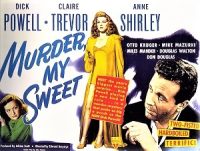
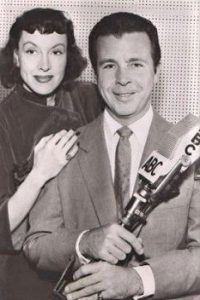
(CD shown at top contains 16 remastered episodes including this week’s episode.)
Play Time : 29:30
{This episode aired on a Saturday in 1949, meaning the neighborhood gang would meet at the corner newsstand the next day after church in search of more thrills and danger of the sort they experienced on the radio the night before. fantastic Adventures (1939-53) was always a favorite even after it folded and was merged with Fantastic in 1953. It was a monthly in 1949. Jungle Stories (1938-54) also supplied thrills and adventure of another sort, as one can surmise from this slight variation on what seemed to be the standard cover, the expected leopard-skin clad female version of Tarzan prominently featured on every cover. It was a quarterly in 1949. The sparkling jewel in the crown of the dark fantasy/horror pulp magazines was Weird Tales (1923-54), “the unique magazine.” It featured all of the most talented and beloved fantasy, horror, and supernatural authors for many decades and its reputation was well deserved. Many of its issues are eagerly sought as collector items at SF and horror conventions. It was a bi-monthly in 1949.}
[Left: fantastic Adventures, 12/49 – Center: Jungle Stories, Winter 1949 – Right: Weird Tales, 1/50]
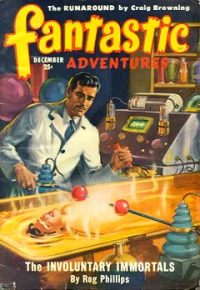
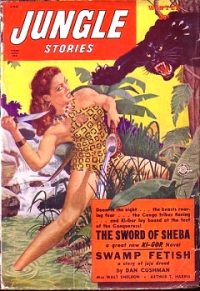
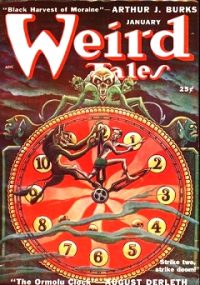
To view the entire list of weekly Old Time Radio episodes at Tangent Online, click here.